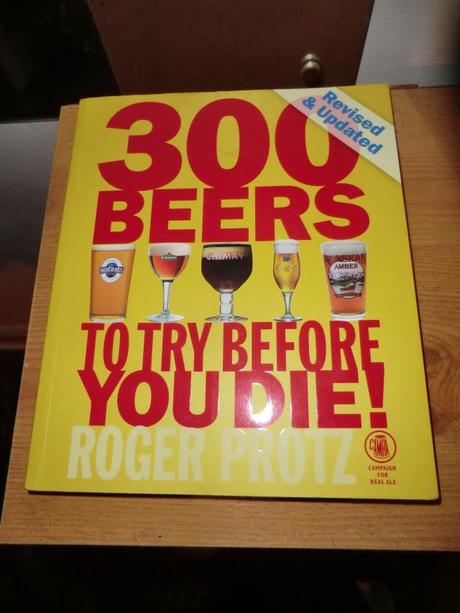
Roger Protz: 300 Beers To Try Before You Die! (CAMRA Books: ISBN: 978-1-85249-273-1)
Ah, the ever cheery do “X” before you die or be eternally a loser books. In this case 300 beers, which I must admit is a much more manageable goal than most of these books set. In this case the beers are picked by a single author – Roger Protz – who is a highly esteemed beer writer here in the UK. Size wise it is about right. Too many beer books these days are going to silly numbers and it gets to the point where you would drink beers from the book without even being aware of it. With 300 to pick from you have a good chance that if you see the beer while out and about it may prickle your memory. With having a single person pick the three hundred you get a sense of character as well that is lost in the collaboration written books. You get a feel for the writers likes an dislikes and that helps guide your interpretation of the beer reviews they write to help you guess if you will like them as well.
Looking through this book you can see an, interesting, bias showing through. Of the three hundred beers over a hundred are in England alone. When you include the rest of Britain it comes in just shy of half. By comparison all of Germany’s, Belgium’s and USA’s combined only just beat out England alone and are less than the Britain total. As a fan of British beer I will happily say we are good, but we aren’t that good! It is like the British version of Rate Beer (A good site for reference but its rating system leads to bias towards areas of larger user populations which tends to mean USA beers end up ruling the roost in ratings). The rest of the world gets a pretty short stick of it as well. New Zealand got not a single beer I could see, and Japan’s growing beer scene got Asahi and Yebisu – hardly their best beers. Part of this can be explained by Protz statement that he tended to pick beers that were able to be imported, as he didn’t want people to have to travel the world to find the beers. Here the UK bias shows again. Many of the beers are cask only UK beers, some times available in only a few or in one case, a single, pub in the UK. So when he says imported, I belive he means imported into the UK. There is therefore a wide variety of beers from the UK shown, but when you go outside that they become for the most part quite predictable in their choices. Beer styles are dominated by their “Home team” with Weisse beers dominated by German beers, Abbey Ales dominated by Belgium, Bitters/Best Bitters and ESB utterly dominated by the UK. Obviously the creators of a style will have a good presence but I would have liked more variety to accept that there are growing beer scenes around the world doing their own takes on the styles.
Some of this can be attributed to the fact that the book, while revised in 2010, was first written back in 2005. A lot of the book seems rooted back there and doesn’t take into account the massive jumps in several countries beer scenes recently.
For all the criticism I am giving this I will say that I was happy to see that, despite being a CAMRA book and thus promoters of predominantly the real ale styles, also showed support for beers such as Meantime who, to the best of my knowledge, aren’t real ale brewers, and also a good range of the lager styles. Against his reputation Protz seems perfectly happy to praise beers that do not follow the CAMRA guidelines where they deserve it and that is very much to the books benefit.
Where this book is strong is the writers knowledge of beer history. Looking backwards into the history of beer he shows deft knowledge of the growth and evolution of beer styles, the tales of Brewers lives and and their family pedigree, and the descriptions off the historical breweries architecture. All this adds a bit of character to what could be quite a dry text. Also the description of what goes into a beer is often very detailed with information on hops, malts and brewing processes. Great information for helping people work out what they like, why, and how to look for it in future beers. I have often called for more information like this to be available to drinkers and this book does that very well. There is information on the color of the beer in brewers measurements, but at no point does he put a guide to compare it to, meaning that unless you already know the scale you have to work it out by comparing photos, which kind of defeats the point. Similarly he lists IBUs occasionally but often without much context. Unless you are already familiar with the scales they aren’t much help.
Unsurprisingly where the guide really shines is in the Real Ales, especially the Bitters, Best Bitters, Milds, Etc. I will admit my own bias here, in that while I enjoy most beer styles (as regular readers of the blog will know) I do find that the Bitters and Milds are least likely to inspire excitement in me, however I have found many good beers in the style over the years and in the current exploding interest in IPAs, Sours, and Imperial Stouts they are often overlooked. However the book does provide a good look at the range available to these more traditional styles. In fact it is very interesting, In the Bitters and Mild section he shows many beers and breweries I had not heard of or tried. For most of the others, IPA , Belgium Ales and the like I found little to surprise me, but in the bitters Protz revealed many more obscure beers which may help bring back an interest to the style.
This is the beers strength and weakness. I do get the feeling that by personal preference or publishers intent, Protz would have been more at ease doing a 200 British Beers book, and it is in that and the real ale arena that he reveals the most surprises. His knowledge is not lacking in other beers, but the list seem much more towards the expected.
So a book with a distinct slant, and with great knowledge of the history and brewing process. From the beers I have tried on the list I find a mix of beers I love (Sarah Hughes Dark Ruby and Gouden Carolus Classic) and ones I find dull examples of the style (Marstons Old Empire is not a favoured IPA of mine, nor Worthington’s White Shield) however with the benefit of a single writer it allowed me to work out what he liked or didn’t like in particular beers so could get a feel for if I would like the others. The book also tends away from the odd and irregular of the beer world, which I will again admit is the area of the beer world I have quite a bias for.
So overall, as a general book on world beer I find it lacking, however I think as a guide book for someone coming to the UK who wanted a guide to where to find many traditional beers it could be very useful. So a useful and well informed guide, but one that follows a different path to the one I enjoy. Hopefully from this review I have given you enough information to decide if that holds for you or not.

